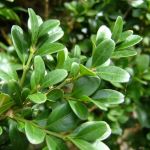| Common Name: |
Common Boxwood |
| Botanical Name: |
Buxus sempervirens |
| Genus: |
Buxus |
| Family: |
Buxaceae |
| Native Location: |
Europe, N Africa, Turkey |
| Cultivation: |
Well-drained, neutral to alkaline soil in sun or shade. Plant 20cm (8in) apart for hedges. Cut back hard in late spring to encourage new growth. Trim hedges and topiary specimens to shape in summer. Buxus sempervirens 'Elegantissima' tends to revert if pruned too hard or too often. Leaves may be affected by leafspot or rust. Young leaves may be attacked by boxwood psyllids. |
| Propagation: |
By semi-ripe cuttings, with some hardened wood at the base, in a mixture of peat or peat substitute and sand, or directly into the ground in a shaded position. Cuttings can be taken at any time (best in autumn). |
| Harvest: |
Leaves are gathered in early spring, before flowering, and dried for infusions. |
| Warning: |
All parts are toxic if eaten. Possible skin irritant or allergen. |
| Height: |
2-5m (6-15ft), occasionally 10m (30ft) |
| Width: |
1.2-2m (4-6ft) or more. |
| Varieties: |
Elegantissima
(Silver boxwood)
Is dense and slow-growing, with white-edged leaves, to 2cm (¾:in)long
Handsworthensis
Is dense and upright, with leaves to 4cm (1½in) long;
good for hedging.
Kingsville Dwarf
Is very slow growing, increasing by only 1cm (3/8in) a year;
Ideal for bonsai
Height: 1m (3ft)
Width: 1m (3ft)
Latifolia Maculata
Forms a dense, mound-shaped shrub, with leaves marbled dull yellow;
New leaves bright yellow in a sunny position
Height: 1-2m (3-6ft)
Width: 1-2m (3-6ft)
Marginata syn "Aureomarginata"
Has yellow-margined leaves
Suffruticosa
(Edging boxwood)
Is compact, dwarf, and slow growing
Ideal for formal hedging or topiary.
Height: 1m (3ft)
Width: 1.5m (5ft) |
| Hardiness: |
Z5-8 |
| Parts Used: |
Leaves, bark, wood |
| Properties: |
A strong-smelling, narcotic herb that lowers fever and may have anti-rheumatic effects. Destroys intestinal parasites. |
| Medicinal Uses: |
Internally for recurrent fevers (for example, malaria). Dosage is critical; excess causes vomiting, convulsions, and death. Also used in homeopathy for rheumatism. |
| Economic Uses: |
Included in preparations to stimulate hair growth. Wood used in engraving. |
| Bibliography: |
Encyclopedia of Herbs by Deni Brown Copyright © 1995, 2001 Dorling Kindersley Limited. Pp 148-149 |
